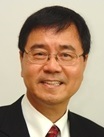 |
Name |
王康隆
Kang-Lung Wang |
| Title |
Distinguished Chair Professor |
| Education |
1970, Ph.DElectrical Engineering, Massachusetts Institute of Technology |
| Office |
|
| Tel |
|
| E-mail |
wang@ee.ucla.edu |
| Web |
|
| Experiences |
- 2016 – Present Associate Editor, Science Advances
- 2011 – 2014 Editor-in-Chief of IEEE Transactions on Nanotechnology TNANO
- 2009 – Present Director, Joint Center of Excellence on Green Nanotechnology (KACST-CA)
- 2006 – Present Raytheon Chair Professor of Physical Electronics
- 2006 – Present Director of Western Institute of Nanoelectronics WIN
- 2007 – 2013 Associate Director of California NanoSystems Institute CNSI
- 2003 – 2013 Director of Marco Focus Center on Functional Engineered Nano Architectonics FENA
- 2000 – 2002 Dean of the School of Engineering, Hong Kong University of Science and Technology
- 1993 – 1996 Electrical Engineering Department Chair, University of California, Los Angeles
- 1979 – Present Professor, University of California, Los Angeles
- 1977– 1981 Adjunct Professor, State University of New York at Albany
- 1972 – 1979 Physicist/Engineer, General Electric Corporate Research and Development Center
- 1970 – 1972 Assistant Professor, Massachusetts Institute of Technology
|
| Awards |
- Academician of Academia Sinica, Taiwan (2016)
- Pan Wen Yuan Outstanding Research Award, Hsinchu, Taiwan (2015)
- Outstanding Alumni Award of National Cheng Kung University, Taiwan (2012)
|
| Research |
|
Currently, Dr. Wang works on the physics, materials and devices for low energy dissipation in electronics and spintronics. He continues to advance the frontiers in these areas. His recent work on topological insulators is of a prime example. His continuous work results in various mechanisms to improve the performance of magnetic memory and devices to reduce dissipation. More recently he works on spin orbit torque, and other innovative areas of spintronics.
Spin-Orbit Torque: He continues to study the spin orbit coupling and its engineering for energy efficient physics, mechanisms and devices. To improve the energy efficient switching of magnets, he explores the use of the spin-momentum lock of Dirac fermions of the surfaces states of topological insulators, e.g., BiSbTe for spin orbit torque and switching of magnetic thin films. He has discovered giant spin orbit torques from the Dirac fermions. In addition to the important practical applications, it points to the new research directions to further uncover the engineering of SOC.
Magneto-Electric Magnetic Random Access Memory (Me-RAM): His work on voltage controlled magnetic memory continues to improve the efficiency of voltage control by lifelong interface materials
and structures. As a result, the working voltage is continuously scaled down to further reduce energy dissipation. His work also extends to antiferromagnetic materials which will have a potential of increasing performance frequency to THz.
Topological Insulator and Molecular beam epitaxy (MBE): He has worked on MBE growth and characterizations for several decades. Recently he is one of the leaders in growth of topological insulators,
dilute magnetic semiconductors. This long term research led to many breakthrough in condensed matters such as discovery of giant spin orbit torque and quantum anomalous Hall, dissipationless transport without applied magnetic field. His research continues towards understanding new physics and developing material and devices for room temperature operation. His creative material growth by MBE led to the consistent reproducible result of quantum Anomalous Hall effect. The consistent reproducible result led to his recent discovery/verification of hypothetic Majorana Fermions.
|